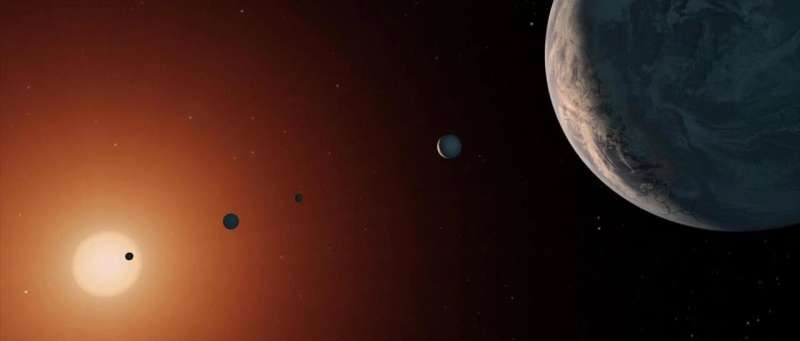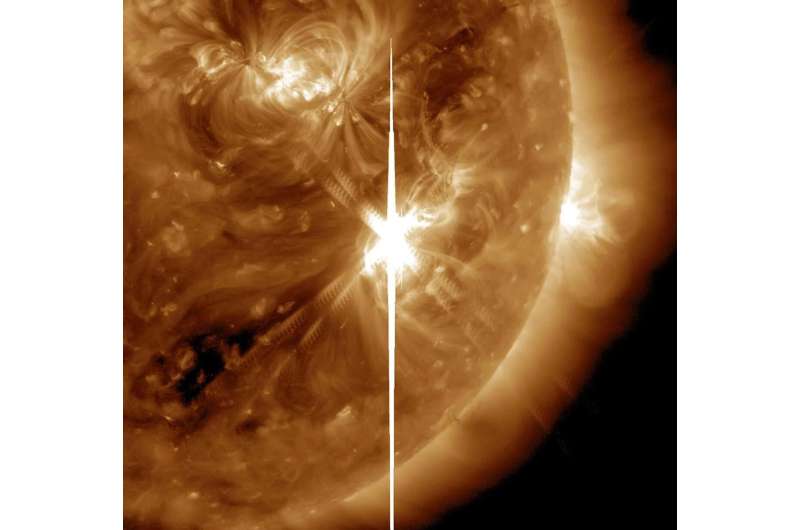This article has been reviewed according to Science X's editorial process and policies. Editors have highlighted the following attributes while ensuring the content's credibility:
fact-checked
peer-reviewed publication
trusted source
proofread
New observations of flares from distant star could help in search for habitable planets

Astrophysicists have used the James Webb Space Telescope (JWST) to take a close look at a volatile star.
In a new study, an international team of researchers has made a detailed investigation of four solar flares exploding from around the star TRAPPIST-1—a small and active celestial body located about 40 light-years from Earth. The findings could help scientists search for far away planets, or "exoplanets," that resemble our own and may even support life.
"Because of JWST, it is the first time in history that we've been able to look for planets around other stars that have the sorts of secondary atmospheres you could find around, say, Earth, Venus or Mars," said Ward Howard, lead author of the new research and a NASA Sagan Fellow in the Department of Astrophysical and Planetary Sciences at CU Boulder.
That hunt, however, can get a little tricky.
Howard explained that most of the small and rocky worlds that scientists are planning to explore with the Webb telescope orbit a class of stars called M-dwarfs, or red dwarfs. They are some of the most explosive stars in the galaxy. Take TRAPPIST-1, which hosts seven known planets. This star is barely bigger than Jupiter, but it shoots out large flares, or bright and powerful eruptions of energy, several times a day, spreading radiation far into space. Earth's sun, in contrast, experiences similarly sized flares only about once a month.
As a result, viewing a planet around a red dwarf can be a bit like snapping a photo of a friend in a dance club with pulsing lights.
In their new research, Howard and his colleagues think they've discovered a partial solution. Using the Webb telescope, the most advanced telescope ever launched into space, the team recorded a series of flares bursting from TRAPPIST-1 over roughly 27 hours. The researchers developed a mathematical method for separating the light coming from those flares from the star's normal radiation. It's a bit like using a filter to remove the glare from a smartphone photo.
The result? Potentially clearer images of planets, and their atmospheres.
"If we want to learn more about exoplanets ," Howard said, "it's really important to understand their stars."
The study has been accepted for publication in The Astrophysical Journal and posted online on arXiv ahead of print. The observations used in the research were obtained in the telescope's first year of operation by Olivia Lim and David Lafrenière at the University of Montreal as part of an effort called the NEAT Collaboration.

Precious planets
Scientists have had their eyes on TRAPPIST-1 for a long time.
This star, which isn't too far from Earth in galactic terms, is a planetary gold mine: It hosts three small and rocky worlds that rest in what researchers call the "habitable zone"—a region around a star in which water could, theoretically, exist on the surface of a planet. Astrophysicists are using the Webb telescope to see if they can sniff out the traces of an atmosphere around these planets. (Lim led a recent study that didn't detect traces of atmosphere around one planet in the system called TRAPPIST-1 b).
"There are only a handful of stellar systems where we have the opportunity to look for these sorts of atmospheres," Howard said. "Each one of these planets is truly precious."
Howard noted that because exoplanets like TRAPPIST-1's seven worlds are so far away, astrophysicists can only observe them as they pass in front of their bright stars. But when a star is as chaotic as TRAPPIST-1, that becomes difficult.
"If you don't account for flares, you could detect molecules in the atmosphere that aren't really there, or get the amount of material in the atmosphere wrong," he said.
Sharper observations
That's one reason why Howard and his colleagues wanted to take such a close look at TRAPPIST-1.
Using the Webb telescope, the researchers observed flares from a distant star for the first time ever in certain wavelengths of infrared light—a type of radiation that the Webb telescope is especially attuned to see. The team's data capture the evolution of those four flares in exquisite detail as they evolved over several hours, growing brighter and brighter, then peaking and becoming dim again.
The group was also able to tease apart the light coming from TRAPPIST-1's flares from the star's day-to-day glow. Drawing on that data, the team was able to remove about 80% of the light from the flares from their observations.
Those numbers aren't perfect, Howard noted, but the team's results should help astrophysicists collect clearer and more accurate data on TRAPPIST-1's seven planets. And the researchers could apply their same approach to other similar star systems close to Earth.
"With TRAPPIST-1, we have a really great opportunity to see what an Earth-sized planet around a red dwarf would look like," Howard said.
More information: Ward S. Howard et al, Characterizing the Near-infrared Spectra of Flares from TRAPPIST-1 During JWST Transit Spectroscopy Observations, arXiv (2023). DOI: 10.48550/arxiv.2310.03792
Journal information: arXiv , Astrophysical Journal
Provided by University of Colorado at Boulder





















